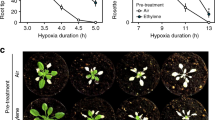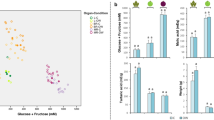Abstract
Ozone has long been known to cause reductions in the yield of crops1 although the precise mechanism of how this occurs is still unclear. Recently, ozone has also been suggested as being involved in the forest decline that has occurred in central Europe2—perhaps in combination with other atmospheric pollutants or with various environmental stresses such as chilling, mineral leaching, insect predation or disease. Consequently, it is desirable that the cellular mechanisms by which ozone is toxic to both crops and conifers, and how they might be modulated by other atmospheric pollutants or environmental stresses, are fully understood. Ethylene is normally produced by all plants and in trace amounts it may interact with other plant growth substances to coordinate a wide variety of developmental processes. However, when plants experience environmental stresses they respond by liberating larger amounts of ethylene—often called stress ethylene3. We have been able to demonstrate, using pea seedlings in an experimental fumigation system4, that the formation of stress ethylene determines the sensivity of plants to atmospheric levels of ozone and to suggest how other air pollutants may enhance ozone-mediated leaf injury.
This is a preview of subscription content, access via your institution
Access options
Subscribe to this journal
Receive 51 print issues and online access
$199.00 per year
only $3.90 per issue
Buy this article
- Purchase on Springer Link
- Instant access to full article PDF
Prices may be subject to local taxes which are calculated during checkout
Similar content being viewed by others
References
Heck, W. W. A. Rev. Phylopathol. 6, 165–188 (1968).
Ashmore, M., Bell, N. & Rutter, J. Ambio 14, 81–87 (1985).
Abeles, F. B. Ethylene in Plant Biology, 302–304 (Academic, New York, 1973).
Whitmore, M. E. New Phytol. 99, 545–553 (1985).
Craker, L. E. Envir. Pollut. 1, 299–304 (1970).
Tingey, D. T., Standley, C. & Field, R. W. Atmos. Envir. 10, 969–974 (1976).
Yang, S. F. & Hoffman, N. E. A. Rev. Pl. Physiol. 35, 155–189 (1984).
Peiser, G. D. & Young, S. F. Pl. Physiol. 63, 142–145 (1979).
Mudd, J. B. in Effects of Gaseous Air Pollution in Agriculture and Horticulture (eds Unsworth, M. H. & Ormrod, D. P.) 189–203 (Butterworth, London, 1982).
Mellor, J. W. A Comprehensive Treatise in Inorganic and Theoretical Chemistry Vol. 1, 897 (Longman, London, 1960).
Finlayson, B. J. & Pitts, J. N. Atmospheric Chemistry: Fundamentals and Experimental Techniques, 441–459 (Wiley, New York, 1986).
Lieberman, M. & Mapson, L. W. Nature 204, 343–345 (1964).
Lieberman, M. & Hochstein, P. Science 152, 213–214 (1966).
Author information
Authors and Affiliations
Rights and permissions
About this article
Cite this article
Mehlhorn, H., Wellburn, A. Stress ethylene formation determines plant sensitivity to ozone. Nature 327, 417–418 (1987). https://doi.org/10.1038/327417a0
Received:
Accepted:
Issue Date:
DOI: https://doi.org/10.1038/327417a0
This article is cited by
-
Impact of Tropospheric Ozone on Crop Plants
Proceedings of the National Academy of Sciences, India Section B: Biological Sciences (2012)
-
Tropospheric ozone as a fungal elicitor
Journal of Biosciences (2009)
-
Regulation of Ethylene Biosynthesis
Journal of Plant Growth Regulation (2007)
-
Perspective of plant growth promoting rhizobacteria (PGPR) containing ACC deaminase in stress agriculture
Journal of Industrial Microbiology & Biotechnology (2007)
-
A Screening Test for the Determination of Ethylene Sensitivity
Environmental Monitoring and Assessment (2006)
Comments
By submitting a comment you agree to abide by our Terms and Community Guidelines. If you find something abusive or that does not comply with our terms or guidelines please flag it as inappropriate.



